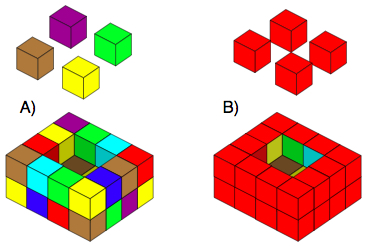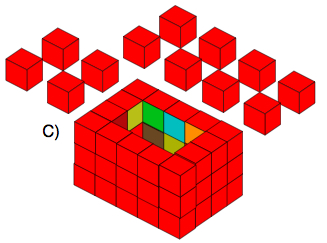Or search by topic
Number and algebra
Geometry and measure
Probability and statistics
Working mathematically
Advanced mathematics
For younger learners
Painting Possibilities



- Problem
- Submit a Solution
- Teachers' Resources
Painting Possibilities
We have an open-topped multicoloured box on the left with four coloured cubes waiting to go in (labelled A in the picture below).
Only the outside has been painted, not the base, nor the inside.
Each of the four separate cubes has been painted all over.

The box always has walls and base that are just 1 cube thick.
Covering one face of a little cube uses 1 unit of paint.
CHALLENGE 1
How many units of paint have been used to turn the muliticoloured box (A) into the painted box (B)?
How many units of paint have been used to cover the four cubes that fit in the box?
Here is another example which would need twelve little cubes to fill the open box (labelled as C):

Similarly how many units of paint have been used for the outside of the box?
How many units of paint have been used to cover the twelve cubes which fit inside it?
Do either of these two boxes use the same amount of paint as the cubes that would fill them?
CHALLENGE 2
Find the size of an open box that needs the same amount of paint to cover the cubes that fill it as its outside.
CHALLENGE 3
In diagram B, the number of units of paint needed to cover the box is 20 more than the number needed to cover the four cubes that fill the box.
Can you find some more open boxes which use 20 more units of paint to cover their outsides than to cover the cubes that fill them?
Why do this problem?
This activity was designed for the 2016 National Young Mathematicians' Award (NYMA) so it might be a particularly useful activity for a small group of your highest-attaining pupils to work on. (For more information about the NYMA, see this brief article which is part of this feature.) This task is a useful vehicle for developing systematic approaches. It can be used as an activity to encourage children to explain in written or spoken words what it is they have done.
Possible approach
Since this activity is aimed at the most confident mathematicians, there will not be much that you have to do to introduce it. However, it would be worth making the first open box and encouraging the pupils to discuss their different ways of answering the first challenge.
Working as a team of four pupils with 32 cubes for them to use for the remaining challenges encourages a very thoughtful and systematic approach.
You may find this double-sided sheet of the challenge useful for printing and giving out to learners: pdf or Word document
Key questions
Tell me about how you are getting a solution for the challenge you are working on.
(When encouraging the pupils as they work on the task, try to avoid saying things about what you notice and directing them in your way of attempting a solution.)
Possible extension
Learners might like to try the other two challenges that were part of the National Young Mathematicians' Award 2016: Dart Target and Open Squares.
You may also like
Prompt Cards
These two group activities use mathematical reasoning - one is numerical, one geometric.
Consecutive Numbers
An investigation involving adding and subtracting sets of consecutive numbers. Lots to find out, lots to explore.
Exploring Wild & Wonderful Number Patterns
EWWNP means Exploring Wild and Wonderful Number Patterns Created by Yourself! Investigate what happens if we create number patterns using some simple rules.

